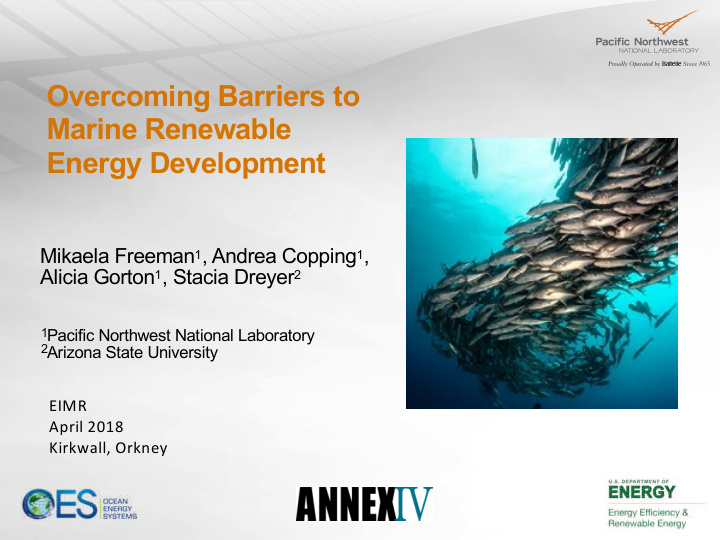



Overcoming Barriers to Marine Renewable Energy Development Mikaela Freeman 1 , Andrea Copping 1 , Alicia Gorton 1 , Stacia Dreyer 2 1 Pacific Northwest National Laboratory 2 Arizona State University EIMR April 2018 Kirkwall, Orkney
Barriers to Consenting MRE industry perceptions Our perceptions of the regulatory community Annex IV working to bridge these gaps 2018 theme: Data Transferability and Collection Consistency Learning as we go… 2
Engaging Regulators 2017 Held two regulator webinars: Environmental Effects of Permitting MRE Development Environmental Effects of MRE Development: Regulator Survey Results and Next Steps US Regulator Survey 2018 White paper on “Data Transferability and Collection Consistency” 5 regional Workshops (in-person and online) ICOE workshop 3
Regulator Survey Regulatory Needs for Environmental Effects of Consenting MRE Goal Understand information needs, key uncertainties for consenting Outcome Better understanding of regulator knowledge Methods to best work with regulators 4
Participant backgrounds US Participants Familiarity with MRE technologies Not very familiar with different wave and tidal technologies Federal State 43% Offshore wind technologies 57% were the most familiar to participants Federal more familiar with wave and tidal than state 5
Challenges for Permitting MRE Devices Single Device Top Challenges Chemical releases EMF effect on animals Benthic/habitat disturbance Collision risk Effects of underwater sound noise Avoidance, attraction, and/or displacement of animals Energy removal/changes in flow Entanglement in lines and cables 6
Challenges for Permitting MRE Devices Arrays Top Challenges Chemical releases EMF effect on animals Benthic/habitat disturbance Collision risk Effects of underwater sound noise Avoidance, attraction, and/or displacement of animals Energy removal/changes in flow Entanglement in lines and cables 7
Can data collected from other locations be applied towards environmental permitting within your jurisdiction? 100% Percent of participants 90% 80% 70% 60% 50% 40% 30% 20% 10% 0% Never Maybe Ab so lute ly Fede ral (n =14) Sta te (n =20) 8
Conclusions of Survey Participants indicated: Difference in impacts between single device and array Risk increases with scale, but more data needed Data transferability should be further explored No one answered “never” 25% state regulators and 36% federal answered “absolutely” 9
Data Transferability and Collection Consistency Challenges: Lack of access to data from early stage projects Lack of consistent methods for data collection No mechanisms to apply data/information between projects Goal: to transfer learning from early projects to inform future projects What do we mean by “data”? We really mean data and information: Could be raw or quality controlled data but more likely analyzed data, synthesized data to reach some conclusion, reports, etc. 10
Working with US Regulators Data can be transferred from: Research studies and established projects (monitoring) Other industries with similarities Site specific data collection could be reduced Data for “transferring” need to be collected consistently for comparison 5 Data Transferability Workshops (~2 hours) Share MRE data, understand regulators’ needs and willingness to transfer data Gather feedback on our data transferability framework 11
Sample data from regulator workshops Tidal turbines at EMEC 12
Sample data from regulator workshops WECs at WETS (Hawaii)
Annex IV proposes: Framework for Data Transferability Develop common understanding of data types and parameters to address potential effects of MRE development. Create best practices for consistent collection of data. Engage regulators to test framework, solicit input on acceptance for data transfer. Guide implementation of best practices for siting, permitting, post- installation monitoring, and mitigation. Framework: 1. Method for describing environment, evaluating the comparability of data sets (MRE project archetypes); 2. Description for applying framework; and 3. Method for implementing framework, to support regulatory processes June 19, 2018 14
Framework: MRE Project Archetype Underwater Noise Stressor Site Conditions Technology Receptor MRE Project Underwater Noisy Tidal Device Marine Noise Environment Mammals Archetype 15
Framework hierarchy 16
Next Steps Continue seek their input from US and other Annex IV country regulators, on what is needed Draft BMPs for data transferability Explore researchers’, developers’ perspectives: Workshop at ICOE in Cherbourg, France, Tuesday June 12 th 2018 Present findings via web-based tool on Tethys https://tethys.pnnl.gov/ 17
Thank you! Andrea Copping Pacific Northwest National Laboratory andrea.copping@pnnl.gov +1.206.528.3049 Mikaela Freeman Pacific Northwest National Laboratory mikaela.freeman@pnnl.gov +1.206.528.3071 18 18
Recommend
More recommend